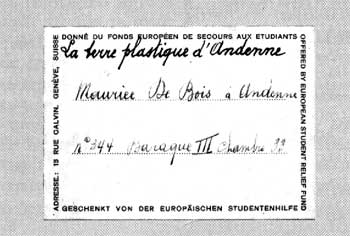 |
|
|
Rüdiger Articus: |
|
|
|
|
||
|
Karl Baeumerth/Martin Kügler: |
|
|
|
Here the so far not published biographical data of 26 pipe bakers
in Marburg from 1679 to the middle of the 19th century are presented.
The oldest documents are naming in 1679 NN Strack, a former soldier,
who makes pipes, and in 1690 Daniel Petit. If nothing is known on
these two, on pipe bakers of the 18th century one has exhaustive indications.
|
||
|
Michaela Hermann: |
|
|
|
During excavations which lasted from 1998 up to 2001,
in Augsburg, Kitzenmarkt, in
|
||
|
Rainer Immensack: |
||
|
Under the term of the Ulmer maser pipes we summarise
the production of pipes made of several varieties (elm, alder, birch,
maple etc.) in the city of Ulm as well as in a vast surrounding country.
Thus the oldest archival document (1695) does not originate from Ulm
itself, but from Geislingen.
Ill. 1: Ulmer giant pipe bowl from around 1800, 22,5
cm high,
|
Ill 2: Glance in a pipe maker workshop around 1835 with the different working steps: filing, drilling, adjusting and polishing.
|
|
|
André Leclaire:
|
|
Ill. 1: The clay stamps.
|
Ill. 2: Utensils for the manual stem decoration from
the workshops
|
|
Katarzyna Meyza: |
||
Ill. 2: The clay appliances for "German pipes". |
By the renewed interpretation of a find in Warsaw
proof can be provided that here too, in a pottery to the edge of the
old part of the city, during two periods, pipe bowls were manufactured.
Although only few examples of the production of the end of the 17th
century are available, data can be won thanks to the recent copies
of the first half of the 18th century. Accessories for the baking
were found with protruding elements on which bowls were attached.
Also the simple cupola kiln of the found rests can be rebuilt. It
is characteristic that anyway the clay pipe rests from both periods
come from ceramist workshops, which manufactured model bowls, but
no clay pipes with passing through stems.
|
|
|
Barnabas T. Suzuki: The supply of Dutch emigrants in Japan with clay
pipes in the 17th and 18th centuries
Ill. 1: Kiseru from the excavations of the Dutch establishment in Hirado.
Ill. 2: Glazed porcelain pipe "Oribe kiseru" from ca. 1620. |
|
Ralf Kluttig-Altmann/Martin Kügler:
|
|
Ralf Kluttig-Altmann/Martin Kügler:
|
|
New Finds
|
Ill 3: Marks on Erfurts clay pipes finds. |
||
|
Bernd Standke: Ill. 1: Clay pipes of Johann Gräfe in Grimma, dating from 1740 to ca. 1748. |
|
|
Thomas Weitzel / Martin Kügler: Ill. 1: Clay pipes from Emden. |
|
Natascha Mehler: |
||||
|
The here exemplarily introduced finds of Amberg, Kempten, Salzburg, Passau and Nuernberg are so far the only representatives of their type in Bavaria and Austria. They stand clearly out against the many clay pipes found in Southern Germany, they are only seldom similar to well-known clay pipes of other parts of Germany and gradually crystallise their own "pipe tradition".
|
||||
|
Where the copies of Salzburg, Kempten, Passau and Nuernberg were made, can not yet be answered at the current state of research. It concerns a pipe bowl, which answers to new finds of Silesia/East Saxony, inspired by Turkish pipes, a green glazed pipe bowl with the initials "PSML" on both sides as well as two pipes with bowls like a shoe: in the piece of Passau the bowl is designed as a shoe, of which the point (the stem) is swallowed by a fish; the new find of Nuernberg is arranged entirely as a shoe (boot), with a very long point.
|
||||
|
Ralf Kluttig-Altmann: |
Ill. 1: The puzzling item of Burg Scharzfels in Harz.
|
|
|
Rory Dunlop / Natascha Mehler:
|
|||
|
Finds of three excavations in Bergen are presented.
Since the production in Norway starts only late, the clay pipes were
imported mainly up to 1752 from the Netherlands, as the find spectrum
also shows. Emphasis must be laid on a shard of faience with the representation
of a pipe smoker, which must have been manufactured by 1700, and of
which the origin is though still unknown.
|
||
|
Martin Kügler: Ill. 1 + 2: Plastic pipes - deceivingly real. |
|
|
|
|
|
Martin Kügler: |
||
Ill. 1: Pipe forms for chocolate pipes of Anton Reiche. |
In the two half forms a small roundbottemed pipe
with 10.5 cm long smooth stem is left empty. The half forms are linked
at the head from the outside by a separate made articulation so that
they always can be adapted. The form, which was manufactured by the
company Anton Reiche in Dresden around 1900 is though no tool for
clay pipe production, but served for the production of chocolate pipes. Ill. 2: Pipe forms for chocolate pipes of Anton Reiche. |
|
|
Wolfgang Cremer: |
Ill. 1: Prestige Batak pipe around 1900. |
|
|
|
|
André Dehaybe / Martin Kügler: Ill.1: Frontpage of the notebook of Maurice de Bois. |
 |
|
|
|
||
|
Martin Kügler: |
||
|
Ill. 1: The ensemble. |
||
|
|
||
|
Rüdiger Articus: |
Home
KnasterKOPF
Society
Sitemap
Contact us
Impressum
last update: 2013-11-28